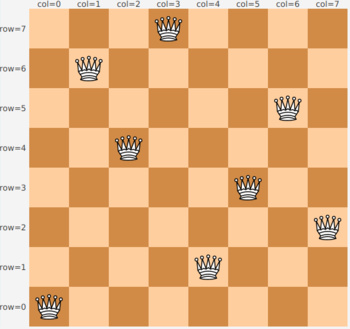Parallel N Queens Assignment
Contents
Parallel Studio
Board State: DefaultImmutableQueenLocations
| class: | DefaultQueenLocations.java | |
| methods: | createNext getBoardSize getColumnOfQueenInRow getCandidateColumnsInRow |
|
| package: | nqueens.lab | |
| source folder: | student/src/main/java |
createNext(row,col)
method: public DefaultQueenLocations createNext(int row, int col) ![]() (sequential implementation only)
(sequential implementation only)
There are two constructors for this class. A public one which creates a fresh new board state with no queens yet placed. and a private one which creates a new board with the state of a given board which is further constrained by a new queen in the next row. You need to create a new instance using one of these two constructors. Which one is it?
Consider this example program which creates a valid 4-queens solution:
int boardSize = 4; QueenLocations board0 = new DefaultQueenLocations(boardSize); QueenLocations board1 = board0.createNext(0, 1); QueenLocations board2 = board1.createNext(1, 3); QueenLocations board3 = board2.createNext(2, 0); QueenLocations board4 = board3.createNext(3, 2); System.out.println(board4);
Which board is used to create the next board?
getBoardSize()
method: public int getBoardSize() ![]() (sequential implementation only)
(sequential implementation only)
Note that we will refer to the standard 8x8 chessboard's size as 8 and not 64.
getColumnOfQueenInRow(row)
method: public Optional<Integer> getColumnOfQueenInRow(int row) ![]() (sequential implementation only)
(sequential implementation only)
For an 8x8 board with queens placed in (row=0, col=1), (row=1, col=6), and (row=2, col=4)
- getColumnOfQueenInRow(0) returns Optional.of(1)
- getColumnOfQueenInRow(1) returns Optional.of(6)
- getColumnOfQueenInRow(2) returns Optional.of(4)
- getColumnOfQueenInRow(3) returns Optional.empty()
- getColumnOfQueenInRow(4) returns Optional.empty()
- getColumnOfQueenInRow(5) returns Optional.empty()
- getColumnOfQueenInRow(6) returns Optional.empty()
- getColumnOfQueenInRow(7) returns Optional.empty()
getCandidateColumnsInRow(row)
method: public List<Integer> getCandidateColumnsInRow(int row) ![]() (sequential implementation only)
(sequential implementation only)
For an 8x8 board with a single queen placed in (row=0, col=4)
- getCandidateColumnsInRow(0) returns []
- getCandidateColumnsInRow(1) returns [0,1,2,6,7]
- getCandidateColumnsInRow(2) returns [0,1,3,5,7]
- getCandidateColumnsInRow(3) returns [0,2,3,5,6]
- getCandidateColumnsInRow(4) returns [1,2,3,5,6,7]
- getCandidateColumnsInRow(5) returns [0,1,2,3,5,6,7]
- getCandidateColumnsInRow(6) returns [0,1,2,3,5,6,7]
- getCandidateColumnsInRow(7) returns [0,1,2,3,5,6,7]
The provided isLocationThreatFree(row, col) method should be helpful.
Search Order: FirstAvailableRowSearchOrder
This class will provide methods that will allow us to implement a clean and efficient parallel solution in the final step.
| class: | FirstAvailableRowSearchOrder.java | |
| methods: | selectedNextUnplacedRow | |
| package: | nqueens.lab | |
| source folder: | student/src/main/java |
method: public Optional<Integer> selectedNextUnplacedRow(QueenLocations queenLocations) ![]() (sequential implementation only)
(sequential implementation only)
For an 8x8 board with queens placed at (row=0, col=0), (row=1, col=3), (row=2, col=6), and (row=6, col=7):
- selectedNextUnplacedRow(queenLocations) returns Optional.of(3)
For a board with no unplaced rows, for example, a solution:
- selectedNextUnplacedRow(queenLocations) returns Optional.empty()
In cases where a row does not have a queen placed in it, but has no valid candidate columns, for example a 3x3 board with a queen placed at (row=0, col=1):
It is critical that
- selectedNextUnplacedRow(queenLocations) returns Optional.of(1)
When searching for solutions we do not want to avoid dead rows. If anything, we want to move them to the front of the line, so that search can cease the current fruitless path.
ParallelNQueens
Searching for solutions like n-queens can be done in parallel without the need to finish at each level. As such, forasync is preferable to forall. However:
finish. |
| class: | ParallelNQueens.java | |
| methods: | searchForSolutions countSolutions |
|
| package: | nqueens.lab | |
| source folder: | student/src/main/java |
method: public static int countSolutions(QueenLocations queenLocations, RowSearchOrder rowSearchOrder) ![]() (parallel implementation required)
(parallel implementation required)
Instead of using a MutableInt in order to count the number of solutions we have found, we want to use a Finish Accumulator.
Creating a new instance of FinishAccumulator is done via on of the many static methods on the V5 class (the same class we get async and finish from).
Refer to the syntax page in order to see the syntax for properly setting up the accumulator.
method: private static void searchForSolutions(FinishAccumulator<Integer> accumulator, QueenLocations queenLocations, RowSearchOrder rowSearchOrder) ![]() (parallel implementation required)
(parallel implementation required)




